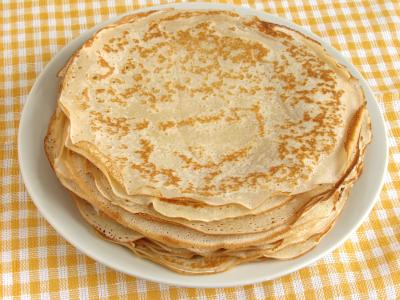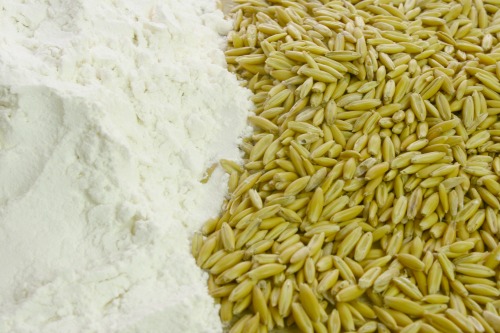What is Spelt Flour?
Article by Charlotte Bradley
Check out all of Charlotte Bradley’s Healthy Lifestyles columns.
 Photo from wikiHow
Photo from wikiHow
Spelt flour is one of the most popular and widely available flours. The full name of spelt is Triticum aestivum var. spelta. You will find pasta, bread, crackers, and baked goods made with spelt flour. Spelt is a cereal grain in the wheat family that has been cultivated for thousands of years – originally in Iran, then Europe and only in the past century has spelt been cultivated in North America. It is similar in appearance to wheat but has a much harder outer shell. Spelt flour has a nutty and slightly sweet flavor similar to that of whole wheat flour. It does contain gluten and is a popular substitute for wheat in baked goods. Spelt has gained popularity in recent years. We have become more aware of the need to vary the grains we consume and we are seeking out healthy alternatives.
Benefits of Spelt Flour:
Spelt is more water-soluble and more easily digested than all-purpose flour. It is preferred by many people with wheat sensitivities and may be an acceptable substitute for some people with gluten intolerance however; it is not gluten-free. Something that is gluten-free will naturally be wheat-free; however the reverse is not true. Therefore spelt would not be a suitable substitute for someone with true wheat allergies or celiac disease.
Even if you are fortunate not to suffer from a wheat sensitivity, spelt can be a great addition to your diet. I like to cook with a variety of grains and flours to help ensure we get a wide array of nutrients and the benefits of many different foods. Spelt flour has slightly more protein and fewer calories than all-purpose flour. It contains a broad array of nutrients and is a good source of vitamin B2, manganese, niacin, copper, phosphorus, protein, and fiber. Spelt has a much tougher outer husk than wheat. During milling, this tough outer shell helps protect the grain, preserving both nutrients and flavor. It also helps protect the grain from pests and infestations which makes it much easier to grow without the use of pesticides.
Buying and Storing Spelt Flour:
Spelt flour can usually be found in the organic section of your local grocery store. Often you can find it in bulk food or natural food stores. Make sure there is no sign of moisture in the package or container. If you are buying in a bulk food store, make sure there is a high turnover at the store to ensure the product is fresh. Spelt flour should be refrigerated, however if you are going to be using it within a few days, it is fine stored in an airtight container on a cool, dark shelf.
Using Spelt Flour:
Just like all-purpose flours, spelt flour comes in two varieties; whole or white spelt. White spelt flour has had the bran and germ removed. It will give you a lighter texture in baked goods and works well as a substitute in recipes that call for all-purpose flour. Whole spelt flour is close in texture to whole wheat flour.
Because spelt is more water-soluble than wheat, it is often recommended to use three quarters the amount of liquid in a recipe when making substitutions for wheat flour. I have found that this varies depending on the particular batch of spelt flour and the recipe. I will usually start with a bit less liquid than called for in the recipe and add more if needed to create the appropriate consistency.
The gluten in spelt flour is more fragile than wheat flour. Whereas wheat flour needs to be mixed and kneaded for awhile to strengthen the gluten, you need to be much gentler with spelt flour taking care not to over-mix or over-knead. Over-mixing may result in too a crumbly texture.
Also because of the fragile gluten, products baked with spelt flour do not rise as high as those that use wheat. I have found when baking bread with spelt flour, the best way to get a nice rise is with a starter. Spelt was one of the first grains ever used to make bread and in fact is even mentioned in the bible. However, if you are new to using spelt flour I would recommend starting with a less ambitious project.
My sister is sensitive to wheat and has successfully cooked and baked with spelt flour for many years. One of my favorite recipes is her Spelt Crepes. It is a delicious and easy introduction to cooking with specialty flours.

 Charlotte Bradley is the publisher of YogaFlavoredLife.com and an avid yoga practitioner. She was a student of karate for many years and took up yoga only tentatively after the birth of her sons and a knee injury left her looking for a less high-impact form of exercise. It was love at first pose as Charlotte saw how quickly yoga sped her rehabilitation along. She also found that yogic relaxation techniques lent her proper focus, bringing balance into her life as well as a greater appreciation for how blessed she truly is. She lives in Ottawa, Ontario with her husband and twin boys, Charlie and Patty, who keep her on her feet and on the go. Her golden retriever supervises Charlotte’s yoga workouts from a spare mat, with his eyes closed.
Charlotte Bradley is the publisher of YogaFlavoredLife.com and an avid yoga practitioner. She was a student of karate for many years and took up yoga only tentatively after the birth of her sons and a knee injury left her looking for a less high-impact form of exercise. It was love at first pose as Charlotte saw how quickly yoga sped her rehabilitation along. She also found that yogic relaxation techniques lent her proper focus, bringing balance into her life as well as a greater appreciation for how blessed she truly is. She lives in Ottawa, Ontario with her husband and twin boys, Charlie and Patty, who keep her on her feet and on the go. Her golden retriever supervises Charlotte’s yoga workouts from a spare mat, with his eyes closed.

